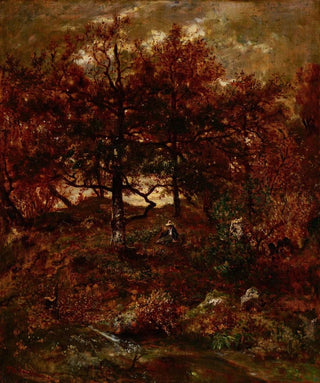Art print | Autumn at St-Jean de Paris Forest of Fontainebleau - Théodore Rousseau


View from behind

Frame (optional)
Autumn in St-Jean de Paris Forest of Fontainebleau - Theodore Rousseau – Captivating Introduction
In the vast panorama of art history, some works manage to capture the very essence of a moment, a season, an emotion. "Autumn in St-Jean de Paris Forest of Fontainebleau" by Theodore Rousseau is one of these iconic pieces. Painted in the heart of the 19th century, this artwork invites the viewer to enter a universe where nature expresses itself with vibrant intensity. The warm colors and delicate shades of autumn blend harmoniously, creating an atmosphere imbued with melancholy and beauty. Rousseau, through his mastery of landscape, transcends the simple natural setting to offer a reflection on the fleeting nature of seasons and the ephemeral beauty of life.
Style and uniqueness of the work
Rousseau's work stands out for its realistic approach and its ability to pay homage to nature in all its splendor. In "Autumn in St-Jean de Paris Forest of Fontainebleau," the artist deploys a rich palette, where oranges, reds, and yellows blend with remarkable delicacy. Every brushstroke seems to breathe new life into the foliage, tree trunks, and the light filtering through the branches. Rousseau manages to capture not only the colors but also the atmosphere of an autumn walk, where the rustling of leaves evokes memories and intimate reflections. His technique, which combines precision and emerging impressionism, makes this work a true masterpiece of French landscape painting, demonstrating a unique artistic sensitivity.
The artist and his influence
Theodore Rousseau, a major figure of the Barbizon School, knew how to mark his era with an innovative approach to landscape. Moving away from academic conventions, he paved the way for a new way of seeing and representing nature. Rousseau drew inspiration from the landscapes of Fontainebleau Forest, a place he particularly cherished, which became the stage for his artistic explorations. His influence is felt not only in the works of his contemporaries but also in those of subsequent generations. By highlighting the

Matte finish

View from behind

Frame (optional)
Autumn in St-Jean de Paris Forest of Fontainebleau - Theodore Rousseau – Captivating Introduction
In the vast panorama of art history, some works manage to capture the very essence of a moment, a season, an emotion. "Autumn in St-Jean de Paris Forest of Fontainebleau" by Theodore Rousseau is one of these iconic pieces. Painted in the heart of the 19th century, this artwork invites the viewer to enter a universe where nature expresses itself with vibrant intensity. The warm colors and delicate shades of autumn blend harmoniously, creating an atmosphere imbued with melancholy and beauty. Rousseau, through his mastery of landscape, transcends the simple natural setting to offer a reflection on the fleeting nature of seasons and the ephemeral beauty of life.
Style and uniqueness of the work
Rousseau's work stands out for its realistic approach and its ability to pay homage to nature in all its splendor. In "Autumn in St-Jean de Paris Forest of Fontainebleau," the artist deploys a rich palette, where oranges, reds, and yellows blend with remarkable delicacy. Every brushstroke seems to breathe new life into the foliage, tree trunks, and the light filtering through the branches. Rousseau manages to capture not only the colors but also the atmosphere of an autumn walk, where the rustling of leaves evokes memories and intimate reflections. His technique, which combines precision and emerging impressionism, makes this work a true masterpiece of French landscape painting, demonstrating a unique artistic sensitivity.
The artist and his influence
Theodore Rousseau, a major figure of the Barbizon School, knew how to mark his era with an innovative approach to landscape. Moving away from academic conventions, he paved the way for a new way of seeing and representing nature. Rousseau drew inspiration from the landscapes of Fontainebleau Forest, a place he particularly cherished, which became the stage for his artistic explorations. His influence is felt not only in the works of his contemporaries but also in those of subsequent generations. By highlighting the






